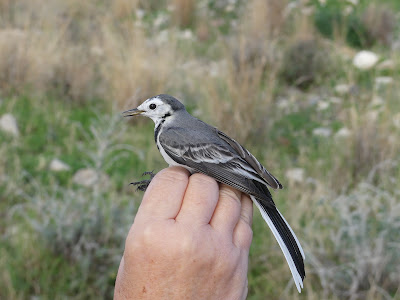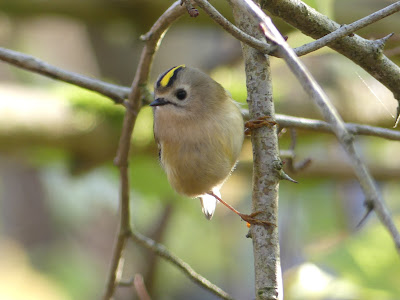We continue with standard ringing until the last date of the season so just two more days to go until we can use tape lures during the morning. Numbers are dropping, but this morning we managed to catch a Fieldfare.
Male Fieldfare
The stragglers are still coming through, with singles of Robin and Goldcrest ringed today. The leading species at present is Mealy Redpoll as we have been managing to tape small numbers after standard ringing is completed. The males are so smart with their 'raspberry ripple' good looks.
2k+ male Mealy Redpoll
Ringing Totals: 32 (7)
Rødhals / Robin – 1 (3)
Sjagger / Fieldfare - 1
Solsort / Blackbird – 0 (1)
Fuglekonge / Goldcrest– 1 (1)
Blåmejse / Blue Tit - 2
Musvit / Great Tit – 0
Stor Gråsisken / Mealy Redpoll – 26
Lille Gråsisken / Lesser Redpoll – 1
Lille Dompap / Western Bullfinch – 0 (1)
In the afternoon we tried for Mute Swan again, catching one bird, in need of food and with a superficial wound on the neck. The bird was relocated to the harbour where it was more sheltered and could feed on grass.
Efforts in the evening focused on trying for owls ( we failed), also a short check at Birkamose beach for waders. Again, there were none (not surprising as beaches are regularly walked by dog walkers and people searching for Baltic amber, even after dark) and we resorted to for looking for amber and fossils along the tide line.
Beach combing finds from our stay here including belemnites, an echinoid
and amber (not found by us but a gift from Hans' own collection)
14th November
After a couple of quiet days it seems that migration is now back on. We recorded a few species that we've not seen for a few days, Greenfinch and Blackcap included, then found there were still some largish flocks of Redpoll around later in the day when we could play tapes. We caught over 200 Mealys, mostly in the afternoon with an Arctic amongst them.
Arctic Redpoll - faint streaking on flanks
Small eye, nasel hairs covering top portion of smaller, neater beak
Unmarked lower back and exhibited tendency to 'fluff up' when held
Undertail coverts barely marked with no strong marking on longest
covert as in Mealy Redpoll
A Kestrel turned out to be the guilty party when a retrapped Robin was killed in the net.
1k female Kestrel
Ringing Totals: 245 (13)
Tårnfalk / Kestrel - 1
Jernspurv / Dunnock - 1
Rødhals / Robin – 0 (6)
Solsort / Blackbird – 1
Munk / Blackcap - 1
Blåmejse / Blue Tit - 8
Musvit / Great Tit – 0 (1)
Skovspurv / Tree Sparow - 3
Bogfinke / Chaffinch - 2
Grønirisk / Greenfinch - 1
Grønsisken / Siskin - 7
Stor Gråsisken / Mealy Redpoll – 206
Lille Gråsisken / Lesser Redpoll – 12
Hvidsisken / Arctic Redpoll - 1
Stor Dompap / Northern Bullfinch – 0 (1)
Lille Dompap / Western Bullfinch – 1 (2)
15th November
The last day of the ringing season and we end on a respectable 46 new. Again, leading species was Mealy Redpoll, 18 of which over half came to tapes in the afternoon. There was also a small party of tits comprising 13 new Blue tits, two Coal tits and another Swedish control Blue Tit.
1k male Coal Tit (Sortmejse)
Tomorrow we will be able to tape throughout the morning and plan to try for thrushes and Redpoll from first thing. We'll see how that goes.
In the meantime the quiet rounds have given me chance to appreciate the site as autumn rapidly advances towards winter.
Less leaves equals more lighthouse
The trees look like this, but still leaves end up in the nets
Autumn bramble
Alder, the Redpolls' favourite
RingingTotals: 46 (10)
Engpiber / Meadow Pipit - 3
Rødhals / Robin – 0 (1)
Solsort / Blackbird – 2 (4)
Sortmejse / Coal Tit - 2
Blåmejse / Blue Tit - 13 (3 including a Swedish control)
Grønsisken / Siskin - 2
Gråsisken / Common Redpoll - 1
Stor Gråsisken / Mealy Redpoll – 18
Lille Gråsisken / Lesser Redpoll – 2
Dompap / Eurasian Bullfinch - 2 (1)
Stor Dompap / Northern Bullfinch - 1 (1)
16th November
We were able to use tapes this morning as standard has now finished. It was very windy, with a clear bright sky. Needless to say catching was poor as birds prefer to get on with migrating in these conditions. Playing Fiedfare was a total of a failure, Redwing produced just one bird and Redpoll produced only 34 birds from the start and end of the day.
A late Blackcap was, well late!
Ringing totals: 38 (3)
Rødhals / Robin – 1 (1)
Solsort / Blackbird - 1
Vindrossel / Redwing - 1
Munk / Blackcap - 1
Blåmejse / Blue Tit - 0 (1)
Musvit / Great Tit - 0 (1)
Stor Gråsisken / Mealy Redpoll – 30
Lille Gråsisken / Lesser Redpoll – 4
The afternoon was spent birding around the lakes at Lolland.
Smew, Goldeneye and Red-crested Pochard
were all seenat this location.
Great White Egret record shot
Marsh Tit regularly visit the table to be fed.
European Nuthatch
We have processed over 1200 Goldcrest in the past six weeks,
but apparently there are still some left in Denmark
17th November
Our last full ringing day at Gedser and birds continued to make their way south. There were quite a few Redpolls around today with 71 Mealys captured and a Belgian ringed 2k+ male.
15378075 (BRUSSELS)
We also identified our third Arctic Redpoll of our spell here.
Arctic Redpoll
Here the two birds show differences between bill and eye structure
Hans had a group at the tip for the morning and they came to see these two birds in addition to a Redwing, Greenfinch and Meadow Pipit.
Ringing totals: 106 (5)
Engpiber / Meadow Pipit - 12
Gærdesmutte / Wren – 1
Rødhals / Robin – 2
Solsort / Blackbird - 3
Vindrossel / Redwing - 1
Munk / Blackcap - 0 (1)
Halemejse / Northen Long-tailed Tit - 7
Blåmejse / Blue Tit - 0 (1)
Grønirisk / Greenfinch - 2
Stor Gråsisken / Mealy Redpoll – 71 (1 control Brussels)
Lille Gråsisken / Lesser Redpoll – 5
Hvidsisken / Arctic Redpoll - 1
Dompap / Eurasian Bullfinch - 0 (1)
Stor Dompap / Northern Bullfinch - 1 (1)
18th November
Our final chance to ring although we have a ferry to catch and need to leave by noon. There is also the small matter of packing and leaving the house tidy. Limiting ourselves to 6 nets we tried Meadow Pipit ( and Lapland Bunting, you need a bit of imagination sometimes) on one group with Redpoll on the other. We took an initial catch and were processing those birds when we noticed another flock of 60 or so birds. We couldn't take the chance of having too many to process in a short time so turned off the tape, closed the two empty nets and extracted what was already there. Within another 15 minutes or so the flock had increased to closer to 200. It was cloudy and birds were chosing to stay rather than push on across the Baltic. It would have been a good catching opportunity if we'd had the whole day.
Totals: 72
Engpiber / Meadow Pipit - 2
Rødhals / Robin – 1
Bogfinke / Chaffinch - 1
Stor Gråsisken / Mealy Redpoll – 59
Lille Gråsisken / Lesser Redpoll – 9
So comes to an end our autumn at Gedser. It was quite different to 2015, no huge number of Goldcrest, although it was a Blue Tit year the 282 on one day wasn't so bad and the small parties of 15 to 20 birds that wandered through ever so often were what helped keep the figures at a reasonable level on quite a few days. It was nice to finish with the Redpolls - three Arctics were very good in a total of less that 1000 birds over October and November. I definitely know what to look for to identify these birds, and find the cline of Mealy through to Lesser equally interesting.
If we were to go again we might try August/September but not for more than a couple of weeks as there is a lot of disturbance with so many beds in the loft and very early starts - perhaps we're beginning to get a bit old for communal living.
To summarise, Gedser is known for large numbers of certain species in the autumn. Robin and Goldcrest in September/October and Redpolls later with ocassional years when Blue Tits move through in high numbers. The rarities are more common in spring, although we captured a Red-flanked Bluetail there in 2015 (and it arrived on a high volume day for Robins).
We were very aware that we could get a busy day, later than usual, as numbers were down earlier in the year. As it turned out there were not extremely high numbers of Goldcrest although they did move through until later in November than usual. Robins were definitely down in numbers while Redpoll numbers were well below that of the bumper numbers in 2017.
- Robin Oct 595, Nov 48
- Goldcrest Oct 762, Nov 521
- Blue Tit Oct 780, Nov 80 (maximum 282 in a day)
- Mealy Redpoll Oct 1, Nov 776
- Lesser Redpoll Oct 7, Nov 98
- Arctic Redpoll Oct 0, Nov 3
Other species that pass through in decent numbers in October and November were Wren 138/27, Dunnock 87/6 (with 206 already processed in September).





































































